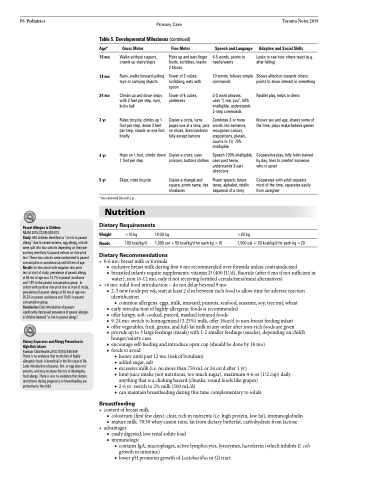Page 1040 - TNFlipTest
P. 1040
P6 Pediatrics
Primary Care
Toronto Notes 2019
Table 5. Developmental Milestones (continued)
Age*
15 mo 18 mo 24 mo
3 yr
4 yr
5 yr
Gross Motor
Walks without support, crawls up stairs/steps
Runs, walks forward pulling toys or carrying objects
Climbs up and down steps with 2 feet per step, runs, kicks ball
Rides tricycle, climbs up 1 foot per step, down 2 feet per step, stands on one foot briefly
Hops on 1 foot, climbs down 1 foot per step
Skips, rides bicycle
Fine Motor
Picks up and eats finger foods, scribbles, stacks 2 blocks
Tower of 3 cubes, scribbling, eats with spoon
Tower of 6 cubes, undresses
Copies a circle, turns pages one at a time, puts on shoes, dress/undress fully except buttons
Copies a cross, uses scissors, buttons clothes
Copies a triangle and square, prints name, ties shoelaces
Speech and Language
4-5 words, points to needs/wants
10 words, follows simple commands
2-3 word phrases, uses “I, me, you”, 50% intelligible, understands 2-step commands
Combines 3 or more words into sentence, recognizes colours, prepositions, plurals, counts to 10, 75% intelligible
Speech 100% intelligible, uses past tense, understands 3-part directions
Fluent speech, future tense, alphabet, retells sequence of a story
Adaptive and Social Skills
Looks to see how others react (e.g. after falling)
Shows affection towards others, points to show interest in something
Parallel play, helps to dress
Knows sex and age, shares some of the time, plays make-believe games
Cooperative play, fully toilet-trained by day, tries to comfort someone who is upset
Cooperates with adult requests most of the time, separates easily from caregiver
Peanut Allergies in Children
NEJM 2015;372(9):803-813
Study: 640 children identified as “at risk to peanut allergy” due to severe eczema, egg allergy, or both were split into two cohorts depending on their pre- existing sensitivity to peanut extract on skin-prick test. These two cohorts were randomized to peanut consumption or avoidance up until 60 mo of age. Results: In the cohort with negative skin-prick
test at start of study, prevalence of peanut allergy at 60 mo of age was 13.7% in peanut avoidance and1.9%inthepeanutconsumptiongroup. In cohort with positive skin-prick test at start of study, prevalence of peanut allergy at 60 mo of age was 35.3% in peanut avoidance and 10.6% in peanut consumption group.
Conclusion: Early introduction of peanuts significantly decreased prevalence of peanut allergies in children deemed “at risk to peanut allergy”.
Dietary Exposures and Allergy Prevention in High-Risk Infants
Paediatr Child Health 2013;18(10):545-549
There is no evidence that restriction of highly allergenic foods is beneficial in the first year of life. Later introduction of peanut, fish, or egg does not prevent, and may increase the risk of developing food allergy. There is also no evidence that dietary restrictions during pregnancy or breastfeeding are protective to the child.
*Use corrected GA until 2 yr
Nutrition
Dietary Requirements
Weight
Needs
<10 kg
100 kcal/kg/d
10-20 kg
1,000 cal + 50 kcal/kg/d for each kg >10
>20 kg
Dietary Recommendations
• 0-6mo:breastmilkorformula
■ exclusive breast milk during first 6 mo recommended over formula unless contraindicated
■ breastfed infants require supplements: vitamin D (400 IU/d), fluoride (after 6 mo if not sufficient in
water), iron (6-12 mo, only if not receiving fortified cereals/meat/meat alternatives) • >6mo:solidfoodintroduction–donotdelaybeyond9mo
■ 2-3 new foods per wk, wait at least 2 d in between each food to allow time for adverse reaction identification
◆ common allergens: eggs, milk, mustard, peanuts, seafood, seasame, soy, tree nut, wheat
■ early introduction of highly allergenic foods is recommended
■ offer lumpy, soft-cooked, pureed, mashed textured foods
■ 9-24 mo: switch to homogenized (3.25%) milk, offer 16oz/d to non-breast feeding infant
■ offer vegetables, fruit, grains, and full-fat milk in any order after iron-rich foods are given
■ provide up to 3 large feedings (meals) with 1-2 smaller feedings (snacks), depending on child’s
hunger/satiety cues
■ encourage self-feeding and introduce open cup (should be done by 18 mo) ■ foods to avoid
◆ honey until past 12 mo (risk of botulism)
◆ added sugar, salt
◆ excessive milk (i.e. no more than 750 mL or 24 oz/d after 1 yr)
◆ limit juice intake (not nutritious, too much sugar), maximum 4-6 oz (1/2 cup) daily
anything that is a choking hazard (chunks, round foods like grapes) ◆ 2-6 yr: switch to 2% milk (500 mL/d)
◆ can maintain breastfeeding during this time complementary to solids
Breastfeeding
• contentofbreastmilk
■ colostrum (first few days): clear, rich in nutrients (i.e. high protein, low fat), immunoglobulin ■ mature milk: 70:30 whey:casein ratio, fat from dietary butterfat, carbohydrate from lactose
• advantages
■ easily digested, low renal solute load ■ immunologic
◆ contains IgA, macrophages, active lymphocytes, lysozymes, lactoferrin (which inhibits E. coli growth in intestine)
◆ lower pH promotes growth of Lactobacillus in GI tract
1,500 cal + 20 kcal/kg/d for each kg >20


